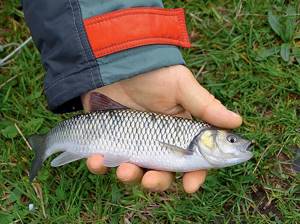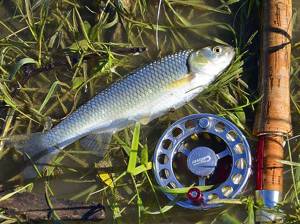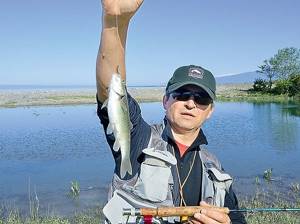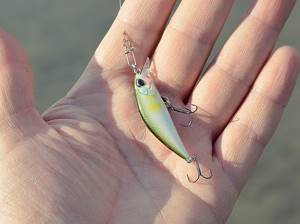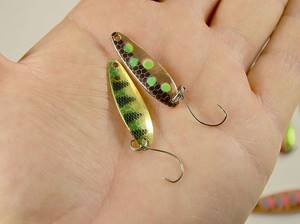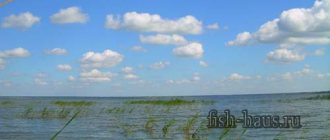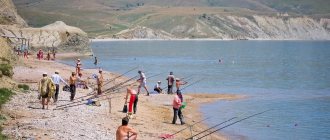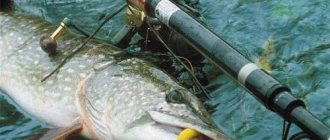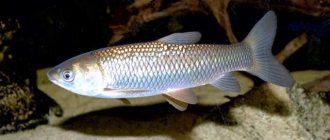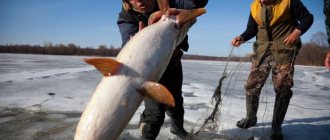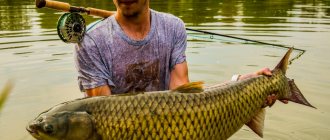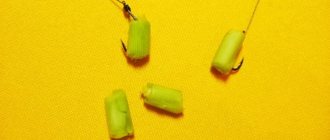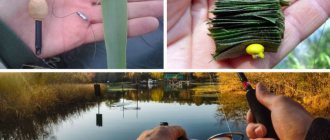Grayling is a fish with an unusual appearance, belonging to the largest “fish” family on the planet. It is not like other salmon (its relatives), but this is not what makes it a valuable object of commercial, recreational and sport fishing.
Grayling meat is a tasty, healthy and absolutely harmless product for human health. And catching it with sports gear is always an exciting, memorable fishing trip. This fish prefers to live on the current, in constant struggle with which it becomes incredibly strong and resilient. When fishing, even a small specimen weighing 200-300 g persists no worse than carp, but catching a trophy specimen is a real victory for the fisherman.
Grayling fish - description
The famous naturalist and popularizer of fishing, Leonid Pavlovich Sabaneev, has repeatedly noted that grayling has the most beautiful color of all known freshwater fish. And indeed it is. What also distinguishes it from other representatives of the ichthyofauna is its dorsal fin of impressive size, which can be compared to a fan or even a flag. It is so large that when folded it reaches the base of the tail.
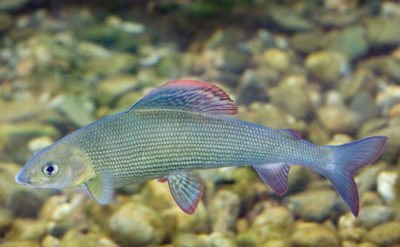
Other distinctive features include the dark gray color of the back, black spots on the sides and a reddish spot above the ventral fins, characteristic of such common species as Siberian or Baikal grayling. On the fins themselves, stripes of the same shade are clearly visible. The anal and caudal fins of adults are reddish-burgundy. The huge dorsal fin is also not devoid of this shade; rows of reddish spots located horizontally are visible on it. All these external features do not allow even a beginner to confuse grayling with some other fish. His body has good streamlining, thanks to which he can quickly move in his native element, including towards the water flow. It is covered with large, tight-fitting scales, which have different colors. This is another distinctive feature. By the way, the color may change. Ichthyologists say that before spawning it becomes very bright and even more attractive.
As for the size of the species, they depend on living conditions (temperature, oxygen saturation of water, amount of food, and so on). For example, some Siberian reservoirs are inhabited by dwarf forms, and Mongolian or European grayling can grow up to half a meter in length and gain 6 kg of weight.
Chub of the mountain rivers of the Caucasus
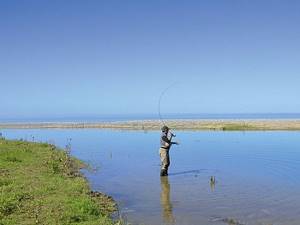
One day, one of the inexperienced fishermen saw several large fish on the shallows.
He didn’t have a fishing rod, he only had a piece of thick fishing line and a large hook.
And this eccentric didn’t come up with anything smarter than winding a fishing line around his palm and, putting a live lizard on the hook, throwing it under the noses of the standing giants.
One of them furiously attacked the offered bait and, being immediately hooked, rushed into the depths.
DRAMATIC DENOUNIUM
The line on the palm tightened and cut the skin of the wrist. The large fish pulled forcefully into the depths, causing unbearable pain to the unlucky fisherman. Fortunately, he was not alone and in a heart-rending voice called a friend for help. Together they defeated the giant and dragged him to shore.
The skin on the arm was torn off several centimeters, and the wound was bleeding heavily. It's good that you had a first aid kit with you. But still, the hand of the lucky winner of the trophy had to be seriously treated.
Read the material “How to protect yourself from ticks?”
This terrible story of the 60s of the last century left me in awe and made me treat a fish called chub very respectfully.
BITTERED BY WASPS
Then two events occurred that strengthened my respect for this fish. Once I met a friend coming from fishing, in whose net I saw a chub weighing about one and a half kilograms. In my understanding, for a small Hosta it was a real monster.
Later we caught chub on a stretch with a large tree fallen into the water. We caught them using processed cheese and wasp larvae, which we called “wasps.” Actually, getting wasp nests, where we took bait from, is a different story. Let me just say that wasps protecting their offspring have bitten us more than once.
|
| The main external difference of the Caucasian chub is the absence of red fins. Photo: Gennady Shelyag. |
THE FISH WAS SAVED BY A TREE
In the company of our peers, we caught several decent chubs weighing 100–200 grams. Suddenly my brother got a bite from a big one. He turned around after hooking on the surface, showing himself in all his glory and confirming that he was indeed a chub, and then rushed under a tree that had fallen into the water, hooked the fishing line on the branches and, taking advantage of our confusion, fell off.
It was a real tragedy for all the kids, my peers, who watched this event.
BIG FISH IN SMALL RIVERS
Having finished the artistic introduction, I will tell you about chub fishing in the mountain rivers of Sochi and Abkhazia, such as Khosta, Sochi, Kudepsta, Gumista and Kodor. The chub lives in almost all large, medium and small rivers flowing into the Black Sea.
Read the material “The Chir River - I made the right decision”
Moreover, it is one of the most elusive migrants of these rivers. It often survives in small rivers such as the Kudepsta, where the water level becomes very low during the summer months. When trophies weighing more than one or even two kilograms are found in the deep holes of this river, it causes real amazement.
FOOD RATION
Since the chub is a predator, its food range in mountain rivers is very diverse. During adolescence, it feeds on insect larvae that go through their developmental stages in the water, and on juvenile fish of all kinds. Once a chub reaches a certain size, it requires larger, higher-calorie food.
At this time, it feeds on all small-sized living creatures that accidentally and not accidentally find themselves in the water. These include fallen insects, larvae, earthworms, minnows, roach, gobies, lizards, and small snakes. Teenagers of podust, barbel, trout and even the chub themselves also become the object of his hunt.
|
| Photo: Gennady Shelyag. |
FISHING AS A RELEASE
As we see, chubs in mountain rivers do not lack food. Its main enemy is powerful floods and great fishing pressure. Sport fishing is developing at an ever faster pace every year. And this is not surprising.
Today it has become an outlet in a crazy race for survival. I can say with complete confidence that a person who spends his weekends with a fishing rod in his hands is spiritually and morally much healthier than someone who “relaxes” in front of the TV or computer.
Read the material “Greed in hunting has been and will be”
And if he also turns off his mobile phone and all communication lines connecting with the world of civilization, he is a real hero.
SPECIAL CHUB
Why is the Caucasian chub special? For many reasons. Firstly, it looks different from the middle zone chub. Large individuals do not have red fins; in the Caucasian chub they are simply gray. In addition, it has a more elongated and slender body shape.
Secondly, the harsh conditions of survival in mountain rivers cannot be compared with the living conditions in the fast and clean rivers of the middle zone. Anyone who has ever observed a phenomenon called an avalanche in mountain rivers will understand me.
AVALANCHE ON A MOUNTAIN RIVER
After a rainstorm or tornado in the mountains, river levels rise tenfold. And then, for a short time, the small stream turns into a raging mud flow, carrying branches, roots and tree trunks, overturning multi-ton blocks of stone and changing its bed beyond recognition.
Read the material “Where to look for fish after a change in water level”
How the fish of mountain rivers, including the chub, survive in this hell remains one big mystery to me. I think some of the fish are washed out to sea, the rest are hidden in deep holes under rocks and other large shelters. One way or another, as soon as the water level returns to normal and the water is cleared, the fish are right there, as if there was no natural disaster.
|
| In such a large river of Abkhazia as the Kodor, fishing with a spinning rod is much more effective. Photo: Gennady Shelyag. |
WHY MUCH BACKING?
Since the chub is a predator, it is the most delicious object for fly fishers and spinning anglers. For fly fishing, rods up to class 4 are used, depending on the size of the river. A reel of the appropriate class must accommodate a line with a leader and leader, as well as a minimum of 100 m of backing with a strength of 20 lb.
I advise you to keep this amount for the Black Sea trout that is accidentally tempted by your fly. This fish is truly crazy, capable of reeling tens of meters from a reel in a matter of seconds.
TAKE EVERYTHING FROM FISHING!
It’s nice to prolong the torment before a large brown trout tears off the thin leader, unwinding all the backing from the reel. It will make you worry as long as possible and run through the water and along the shore in an attempt to “land” the monster with light tackle.
This is exactly why you need a backing reserve of 100 meters (personally, I always keep 150 meters, just for peace of mind).
EVERYTHING GENIUS IS SIMPLE
As a leader material, it is better to use fluorocarbon from 0.1 mm to 0.17 mm, depending on the fishing conditions and the class of gear used. The classic leash length is the length of the rod (possibly with a handle).
Read the material “Spinning without hooks”
Tapered monofilament and fluorocarbon leaders should only be used when dry fly fishing using the dead swim method. In all other cases, it is better to use a cylindrical leash connected to a loop of a floating cord. Nothing extra, everything is brilliantly simple!
|
| Every trophy caught with sports gear is a real holiday. Photo: Gennady Shelyag. |
FLIES USED
All flies should be tied with a loose loop, allowing the front sight to take a more natural position when retrieved.
The range of flies is selected depending on the time of year and the river in which you are fishing. The usual hook size on flies is 8-12.
When selecting flies, the main emphasis should be on small nymphs with golden heads and small streamers. Dry flies are only good to fish when you see fish feeding on the surface.
CAUTION AND AGAIN CAUTION
In addition to the floatant, when fishing for chub, you must have a synket with you to degrease the leader after tying the fly. The chub, especially the large one, is a cautious and sensitive fish. You should fish reaches and holes with a slow current as carefully as possible. The main focus when searching should be on deep holes with minimal current flow.
|
| Photo: Gennady Shelyag. |
ADVANTAGES OF SPINNING
At times, spinning for catching chub in mountain rivers has advantages over fly fishing. Using spinning baits with long deep leads, it is much faster to fish large reaches with weak and medium currents. In addition, when the fish are inactive and standing deeper in holes, spinning fishing also becomes more effective.
Read the material “Parade of homemade donks”
For chub fishing, spinning rods from ultralight to 10–15 grams are used, spinning reels ranging in size from 1000 to 2500 according to the Shimano and Daiwa classification.
FISHING LINES AND LURES
A braided fishing line with a thickness of 0.1–0.13 mm with classic winding on a reel at 1–2 mm to the side of the spool is suitable. Those who like to use fluorocarbon and regular fishing line use them with a thickness of 0.17–0.21 mm. When fishing with braided line, the bait is tied on a fluorocarbon leash 50–70 cm long and 0.18–0.2 mm in diameter.
To catch the cunning fish of the Caucasian mountain rivers, a wide variety of spinning baits are used. The important thing is the size of these baits - from 1.5 cm to 5–6 cm.
You can use wobblers, spoons, spinners, microjigs and some other baits. It all depends on your experience and the predilection of the fish in a certain body of water for certain baits.
|
| Working dimensions of oscillating spoons with a single hook. Photo: Gennady Shelyag. |
ENTER THE GATE WITH WORTH!
Catching special Caucasian chub in special Caucasian mountain rivers is a special experience. This is searching, detecting, tracking and squatting to catch points.
The chub is a cautious fish, which does not allow its fishing to be treated unprofessionally. There are, of course, completely random catches of large trophies. They occur more often in those who can be called real hard workers when fishing.
It is to those who search, try, experiment that the underwater fish kingdom opens its gates. Enter these gates with dignity and remember that each of us bears the responsibility for preserving aquatic biological resources.
And everyone is responsible for the cleanliness of our water bodies. Good luck!
Gennady Shelyag October 12, 2021 at 05:25 pm
Habitats and lifestyle
As mentioned above, grayling loves a strong river flow. Most often it is found in fast, cold rivers fed from mountain glaciers or underground springs. In clean high-mountain lakes located at an altitude of up to 2000 meters above sea level, it also feels great. This fish leads a sedentary lifestyle, inhabiting places with winding riverbeds, rapids, rocky areas, and frequent changes in depth (spits, holes). As a rule, it does not stray far from its lands, the only exception being the spawning period of river grayling. For the sake of procreation, they rise to the upper reaches of the river, covering dozens of kilometers.
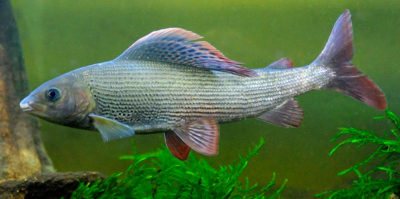
The species is very demanding on conditions; it lives exclusively in clean fresh waters saturated with oxygen. These are not necessarily cold mountain rivers; the fish also takes root in regions where the climate is warmer. Confirmation of this is the Mongolian grayling, which feels great in reservoirs located in the northwestern territories of Mongolia. In Russia, river and stream forms are found in the Middle Urals.
Grayling habitats
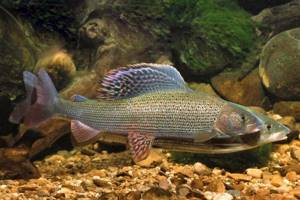
Grayling is found in clean, fresh water with a high oxygen content. It can exist in reservoirs at an altitude of up to 2.4 km, in rivers of the plains, but the main habitats are mountain rivers and large streams. Less often, graylings choose lakes for their residence. Can live in brackish water.
Features of grayling habitats:
- rivers with an uneven bottom made of stones and pebbles, the bed of which is winding;
- prefers rifts and rapids with cool water;
- in winter it hides in deep pools and holes;
- sticks to the shore in small rivers and streams;
- in deep rivers, chooses places away from the shore (swims up to feed in the morning and evening);
- There must be a patch of clean water near the main habitat where he will hunt;
- chooses a place to live nearby with shelter (snags, tree trunks and branches that have fallen into a pond, river bottom vegetation).
In summer, grayling chooses places with calmer currents. There are deep holes and uneven spots in front of river riffles, which is where grayling prefer to hide.
Graylings like to stay alone, so they avoid competition when catching food with their relatives. But there are exceptions, for example, when the river lacks good riffles, holes and flats, then grayling stay in a group of about 7-10 fish.
Main types of grayling
Among the many species and subspecies of grayling, the two most common are the Siberian (thymallus arcticus) and the European (thymallus thymallus). Let's take a closer look at them.
Siberian grayling
Prefers to live in clean, oxygenated water. In the northern and eastern regions of Siberia it is found almost everywhere, and in the southern regions it inhabits cold lakes, oxbow lakes and rivers located in the foothills. This species includes 4 subspecies:
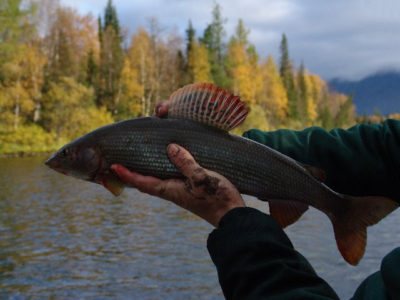
East Siberian;- West Siberian;
- Alaskan;
- Kamchatka
The main external difference of the Siberian grayling is its wide, but shorter dorsal fin than its closest relatives. It is dotted with large spots that have a metallic sheen. In addition to the spots on the fin, the East Siberian subspecies also has a number of dark red stripes underneath it. In addition, he is distinguished by a certain “hunchback” (high body).
The growth of this fish depends on the habitat, in particular on the depth and volume of food resources. Graylings living in the polar regions grow slowly and gain 500 g only at the age of 9-10 years. A specimen weighing up to 1 kg is considered a trophy in this region. In small reservoirs of the Kolyma region, dwarf forms are found; the weight of adult individuals barely reaches 200 g.
Siberian grayling breeds in late spring or early summer, that is, at the height of the flood. It spawns in channels far from the main channel, where the current is weaker. Lake representatives of this species choose coastal areas with flowing streams for spawning.
European grayling
Distributed over a large area from Great Britain to the Urals. This is one of the most beautiful representatives of freshwater ichthyofauna, which cannot be confused with any other fish. Its bright body is covered with spots on the sides and back, and there are brown longitudinal stripes on both sides. The color of the paired fins is red or gray-yellow, with quadrangular spots visible on the dorsal. During the mating season, the appearance of European grayling becomes even more striking.
Nutritional Features
Grayling is classified as a predator, but in reality it is an omnivorous fish. The basis of its diet is made up of various crustaceans and insects that live in the water (gammarus, caddisfly, mayfly) or accidentally fall on the water (gadfly, grasshopper and others). During the spawning period, he happily feasts on the eggs of other underwater inhabitants. A hungry grayling is able to quickly “fly up” above the water surface and grab a bug or fly flying by. When food is very tight, he satisfies his hunger with algae.
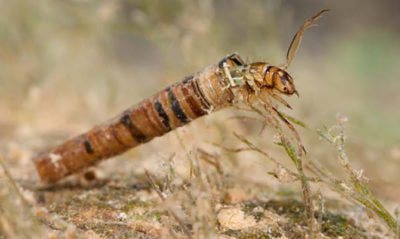
Upon reaching a certain age, food preferences change. Adults begin to hunt fry, setting up ambushes among underwater shelters. Large graylings do not disdain mice and other small animals.
The omnivorous nature of grayling plays into the hands of fishermen. Finding a catchable bait will not be difficult; by and large, any living creature will do.
Reproduction
Grayling spawning can occur three times per season: in mid-spring, if it was warm, at the end of May and in August. The main condition for spawning is the water temperature of at least 5 degrees. The spawning grounds for this fish are shallow waters with a depth of up to half a meter, a slow current and a bottom surface strewn with pebbles. Graylings that live in large lakes spawn almost right next to the shore or go to spawn in small shallow rivers and streams that flow into the main body of water.
Siberian graylings spawn during the maximum rise in water levels, which occurs in the first half of the short summer. The females are the first to go into small channels with clean, transparent water, where each of them can lay up to 10 thousand eggs. After 15-20 days, the fry hatch from them.
Tips for fishermen: conquering mountain rivers
| Zhuravleva Anna (author) |
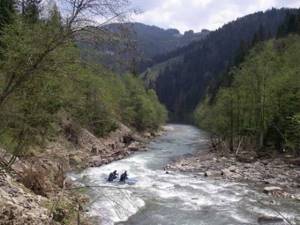
Content:
- Types of fish
- Tackle and bait
- Equipment
Fishing in mountain rivers is not an easy task.
The rapid current, rocky bottom and overgrown banks make approaches to the river difficult to access. The fish that live there are cunning and extremely cautious. But little can compare with the beauty of mountain nature and the pleasure of a rich catch. Small and fast mountain rivers contain fish that need to be studied well, otherwise you won’t expect a catch. If before this you have only fished in flat waters, it is unlikely that you will be able to catch something worthwhile the first time. You need to get used to the peculiarities of this, in its own way, extreme fishing, take a closer look at the terrain, river flow, banks, watch the fish, insects, and weather. In short, this matter requires careful preparation and complete concentration. What kind of fish is found in mountain reservoirs, and what are its habits?
Types of fish
Most of the fish in mountain and taiga rivers are from the whitefish and salmon families. These include trout, salmon, lenok, taimen, grayling and whitefish. In some places, usually in the lower reaches of large mountain rivers, pike are also found in deep areas. Each breed has its own characteristics, despite the common habitat. But any of them is picky about bait and gear.
Trout (aka pied fish) and lenok love the middle current and hide behind stones and snags. It must be borne in mind that when the water is high, trout become more active, move into shallow water and become less cautious. When the water subsides, the fish go to the bottom and it becomes very difficult to catch them.
Pied fish is a daytime fish, it is best to catch it in the first half of the day - from 9 to 15 hours. In summer there will also be a good bite early in the morning and in the evening. Trout is a small but active fish; it often breaks off the hook and can break or tangle the fishing line.
Grayling is a small but beautiful and intelligent fish. He chooses places where several currents merge, or small whirlpools, reaches, and stays on the bottom.
Taimen is a very large, solitary predatory fish that lives under rifts and in deep channels. Since individuals can weigh several tens of kilograms, the gear must be appropriate. The most successful time for fishing is early morning and pre-sunset evening. This giant is caught from May to October.
Whitefish, on the contrary, move in a school and feed on plankton. From mid-July to the end of August, whitefish almost stop pecking, as there is a lot of different food around it.
In general, the most active bite is guaranteed at the end of summer, beginning of autumn, in August-September, when the fish are hungry and the water and air temperatures drop.
Any fish that lives in clean, clear water has excellent eyesight and can easily detect your approach. Therefore, you need to carefully follow the rules of camouflage: protective colors in clothing, silence, smooth movements.
Tackle and bait
The main feature of fishing on mountain rivers is the mobility of the fisherman. After several casts in one place, you need to move on to the next. With experience will come the ability to automatically, by eye, determine where and how many times to throw a hook.
The gear you need to choose is light and compact: a folding spinning rod with a short rod and a small spinning reel or a telescopic fishing rod. And for trout, for example, it is good to catch fly fishing with bait. She can also easily bite on a worm on a regular fishing rod. When using a spinning rod, trout do well on artificial flies and spoons.
As bait for all fish in mountain reservoirs, you can use miniature spinner spoons, mini-wobblers, and small spinner spoons. It is better to have them in different colors and sizes. Having certain fishing skills and knowing the diet of a particular type of fish, you can learn how to make flies yourself.
Grayling, like any predator, can be caught using various live bait, as well as spinners and artificial flies. Taimen prefers wobblers, spinners, and artificial mice. Whitefish are caught using long-distance casting, a fiberglass rod with a foam float, and also with a jig.
Equipment
The most important thing is the right shoes. The fisherman will have to walk a lot along rocky banks, ford rivers in shallow water, or walk through fallen trees. Therefore, you need to have high, strong boots made of high-quality waterproof material with thick soles. These boots should protect you not only from water, but also from snake bites.
Clothing should be tight, well-fitting, covering the body from head to toe. On the head is a headdress with a mosquito net. In addition to flying insects, clothing will save you from ticks.
Good preparation, practical application of the advice of experienced anglers and passion for sports will make fishing in mountain rivers an unforgettable adventure. And the one who has acquired a taste for the business is not far from true mastery.
Video:
Grayling fishing
The best way to fish from the shore is fly fishing using special flies as bait. It is important that the fly imitates the insect as accurately as possible, otherwise the cautious fish will suspect a trick. Grayling has excellent eyesight, so it is very difficult to deceive it with a carelessly made artificial bait. Experienced fly fishermen use the most effective fly patterns, which include the bumblebee, black ant and ostrich feather.
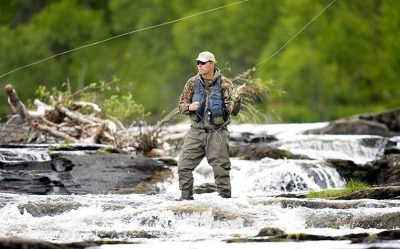
How to catch grayling for those who could not master complex fly fishing gear? Another good way is to wire a fishing rod. The bait in this case can be a worm, whitebait and a piece of fresh fish. If fishing is carried out on a wide river, where long casting is required, the fishing rod is equipped with a spinning reel and the total weight of the weights is increased to 10-15 g.
Trout fishing
For most hunters, fish is of great value - after all, it is a predator. Before fishing, the habits of the fish are also taken into account, because when searching for food, brown trout go to shallow water.
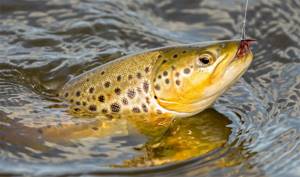
Trout fishing
For fishing, you should choose float gear up to 5 m in order to comfortably move along the shore with large thickets. A worm or maggot is suitable as bait.
Advice! During spawning, trout are found at any depth.
When fishing with a spinning rod, you should choose gear for a specific time of year. In summer, fish live near the surface, so it is better to choose a spoon. Wobblers are recommended in autumn and spring. The best time of day is morning.
To learn more:
What kind of fish is chum salmon?
It is not wise to catch fish after spawning because they lose weight.
Nutritional value
Grayling represents the salmon family, and that says it all. Its meat is not red, but only slightly pinkish, but in taste it is in no way inferior to salmon meat. With low fat content, it is tender and juicy, without bones and the unpleasant smell of mud. It is superior in nutritional value to veal. From such a magnificent product you can prepare a variety of dishes, from ordinary fish soup to fish rolls.
Grayling fish is a valuable source of protein that is completely digestible by the human body. The meat has a balanced vitamin and mineral composition; in addition to healthy protein and a small amount of fat, it contains water. There are no carbohydrates, so dishes made from this fish are considered dietary.
Grayling in cooking
This fish is prepared in a variety of ways: fried, baked, made into fish soup, and salted. There are many recipes, but the most popular grayling dish is rolls, mouth-watering and incredibly tasty. They are very easy to prepare. You need to marinate the fillet in sour cream with the addition of salt, pepper and garlic (amount to your taste). In order for the meat to marinate well, you need to keep it in the marinade for at least an hour. After this, the fillets must be rolled into rolls, secured with a toothpick and fried in a frying pan on all sides until a crust forms.
Fishermen offer their own version of preparing grayling. They are confident that fish meat retains its aroma and taste better if it is cooked immediately after catching. You can cook freshly caught grayling in the wild like this:
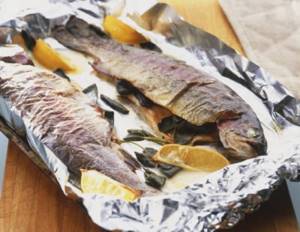
clean and wash thoroughly;- sprinkle with salt and ground pepper;
- wrap in 3 layers of foil;
- bake in hot ashes for 35-40 minutes.
This fish, cooked with smoke, will surprise even a professional chef with many years of experience with its unsurpassed taste.
Video on the topic:
Grayling. His habits and habitats. Thymallus
12:42
Grayling Monster
02:44
Fishing - Fishing for Grayling AUTUMN 2021 (small river LEAF FALL)
11:51
Cold smoking of fish (lenok, grayling) in field conditions
18:57
narybalke
Lower reaches of Sochi mountain rivers
The 2014 Winter Olympics are long over. The city of Sochi and the lower reaches of the Sochi mountain rivers will be unrecognizable after the event.
New ultra-modern highways, railway stations, an airport, hotels have appeared - the resort has been greatly transformed. It has become even more attractive for tourists and vacationers from all over our country, near and far abroad.
Mountain rivers flowing into the Black Sea seem to have very little water and are unattractive for fishing. But only for those who do not know the abundance and diversity of fish that live in these rivers and streams.
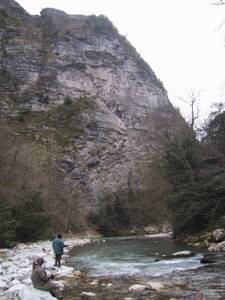
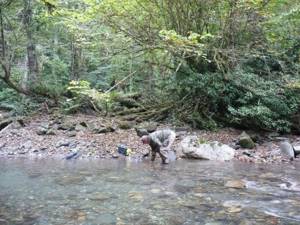
Why are visitors unlucky?
The lower reaches of Sochi mountain rivers and the mountain rivers of Sochi as a whole are a special world of struggle for survival in icy water on a fast current. It’s funny to watch fishermen who came from central Russia and decided to fish here during breaks between swims in the sea.
Such “aliens” certainly find some backwaters where there is no current at all, throw their float gear there and wait for a bite. It’s good if one of the locals can tell you the structure of the equipment, parking places, the correct bait and habits of the local fish.
Otherwise, if there is no result, the desire of visitors disappears very quickly. It becomes completely unclear what, why, where and how to fish in this mountain river.
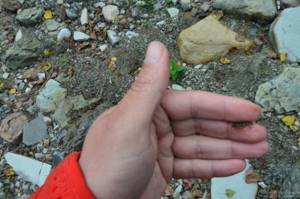
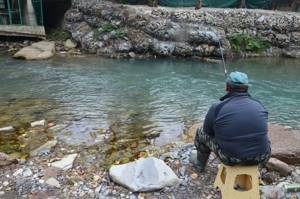
Not so simple
Indeed, fishing in the mountain rivers of Sochi has its own specifics, special requirements for gear, tactics and fishing techniques. Local fishermen are not always willing to share their secrets, perceiving visitors as competitors and an obstacle to successful fishing.
It often happens that, having seen how well one of the local experienced fishermen bites, a visiting fishing enthusiast thinks that everything is simple. He runs to a local store, buys similar gear, takes something he brought with him from home, and goes to the river.
There, without delving into the intricacies of feeding, into the details of the equipment, into the specifics of wiring the float gear, it takes a good place and begins to disturb everyone.
Inhabitants of mountain rivers
Let's start with who lives here. The most common and popular fish in the local rivers is the podust, or “black belly”, as the locals call it. However, the belly of the podust is not black, but white and silver.
The black film is in the inner part of the fish’s abdomen, which must be removed during gutting. Otherwise, this film will give the fish a bitter taste. It is for this need to perform an additional operation when gutting that the locals gave the name “black belly” to this fish.
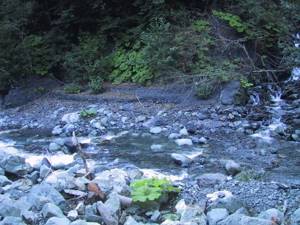
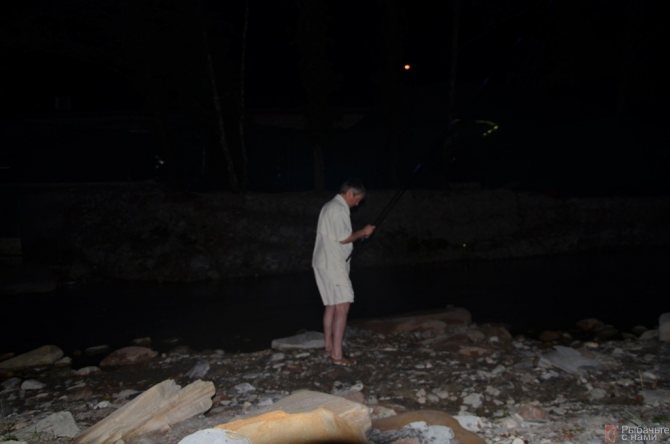
Barbel and chub
Another popular and interesting fish of the local mountain rivers is the barbel. In terms of habits and habitats, this fish is not much different from the podust, so it is most often caught in parallel in the same way. The barbel sticks to the bottom more, sometimes hides under stones and can stand in holes.
The chub in the mountain rivers of the Caucasus differs from the central chub in that its fins are not bright red, but gray and do not stand out from the general color scheme of the fish. Otherwise, it is the same frisky predator, which, due to the extreme living conditions in mountain rivers, has become even more aggressive here.
This fish has a small concentration, but in small rivers reaches impressive sizes - up to 1 kg or more.
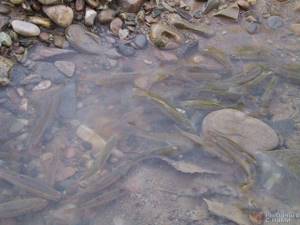
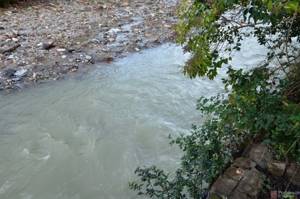
Trout and brown trout
One cannot help but mention the presence in all Sochi rivers of such popular and desirable fish as brook trout and Black Sea sea trout. It is rare that anyone specifically hunts with a fishing rod for these spotted beauties, since their concentration is not very high in the lower reaches of rivers.
Their main abode is impassable mountain sections of rivers. Bites from brown trout and trout most often occur when fishing for barbel and undermouth, while thin leashes breaking off are a common occurrence.
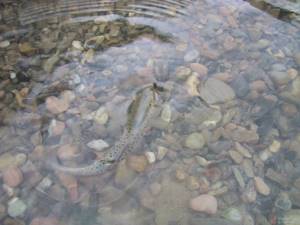
The most common inhabitants of rivers
Now let’s move on to the most widespread, although not the most impressive in size, representatives of the fish community of mountain rivers. First and foremost is the ubiquitous minnow. I remember that in childhood we caught it in dozens and hundreds, stringing it on kukans. Moreover, household matches were necessarily tied to both the upper and lower parts of the kukan. This made it easy to thread the line through the gills and mouth of a small fish.
The roach here rarely reaches a size larger than 10 cm, but in by-catch it is considered a quite decent fish.
The most secretive and peculiar inhabitant of the river bottom is the sculpin goby. This fish always gives surprises, being found in various incredible places.
In childhood, at the very beginning of our fishing practice, we made short half-meter fishing rods from bamboo, to which a piece of fishing line less than a meter long was tied. At the end of this super complex tackle there was an ordinary hook and a small sinker above it.
A dung worm was used as bait. Such equipment was lowered to the bottom next to large coastal stones, in the cracks between them, and then played along slightly. You could feel the goby bite in your hand - it was surprisingly interesting and effective for novice fishermen.
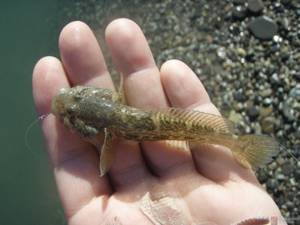
Estuary inhabitants
I have listed the main species of fish that live in mountain rivers and move from the mouth to mountainous areas and waterfalls that are insurmountable for them. In the mouths themselves there are also fish that come from the sea or inhabit only the mouths.
Similar fish include mullet, redfish, vimba, whitefish and some others, which are worth talking about separately, not in this article. Their presence only indicates that fishing in the lower reaches of Sochi rivers is indeed very interesting, versatile and meaningful in all respects.

Gear device
You will need a very light, delicate and fast telescopic rod 5-6 m long with an extremely thin tip. Blind float equipment consists of a main line with a diameter of 0.2-0.18 mm, a float with a load capacity of 0.5-1.5 g, a sinker (sliding along the line) of the appropriate weight, a microcarabiner (1-2 mm), a leash with a diameter of 0.1 -0.15 mm (preferably fluorocarbon) 15-20 cm long. The delicate equipment is completed with a hook, the requirement for which is special.
Maybe
